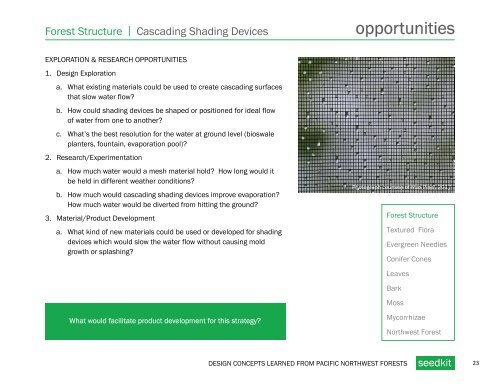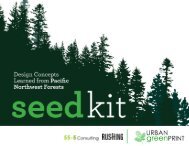You also want an ePaper? Increase the reach of your titles
YUMPU automatically turns print PDFs into web optimized ePapers that Google loves.
Forest Structure<br />
Cascading Shading Devices<br />
opportunities<br />
EXPLORATION & RESEARCH OPPORTUNITIES<br />
1. Design Exploration<br />
a. What existing materials could be used to create cascading surfaces<br />
that slow water flow?<br />
b. How could shading devices be shaped or positioned for ideal flow<br />
of water from one to another?<br />
c. What’s the best resolution for the water at ground level (bioswale<br />
planters, fountain, evaporation pool)?<br />
2. Research/Experimentation<br />
a. How much water would a mesh material hold? How long would it<br />
be held in different weather conditions?<br />
b. How much would cascading shading devices improve evaporation?<br />
How much water would be diverted from hitting the ground?<br />
3. Material/Product Development<br />
a. What kind of new materials could be used or developed for shading<br />
devices which would slow the water flow without causing mold<br />
growth or splashing?<br />
Photograph courtesy of Max Pixel, 2017<br />
Forest Structure<br />
Textured Flora<br />
Evergreen Needles<br />
Conifer Cones<br />
Leaves<br />
Bark<br />
Moss<br />
What would facilitate product development for this strategy?<br />
Mycorrhizae<br />
Northwest Forest<br />
\ DESIGN CONCEPTS LEARNED FROM PACIFIC NORTHWEST FORESTS seedkit<br />
23



